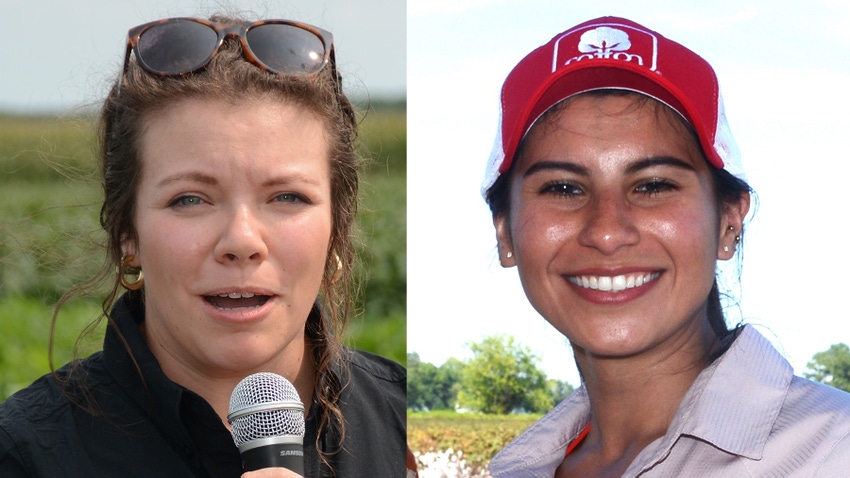
North Carolina State University’s newest Extension plant pathologists spent their first summer on the job working with farmers, attending field days, and scoping out their plans to help combat diseases that present a never-ending challenge for crops in the Tar Heel State.
Both Daisy Ahumada, Extension plant pathologist for cotton, corn, and tobacco; and LeAnn Lux, Extension plant pathologist for peanuts and soybeans; have been on the job since June. Both scientists are new to North Carolina, and both bring impressive credentials to their new assignments.
Pathologist backgrounds
Ahumada, a native of California, earned a B.S. in environmental biology from Cal Poly Pomona in 2018, and a Ph.D. in plant pathology from the University of California, Davis. N.C. In California, Ahumada studied the biology and management of diseases affecting almond and prune tree crops. NCSU is her first position after earning her Ph.D.
Lux, who grew up on a corn and soybean farm in Indiana, earned her B.S. in plant science with a focus in plant biology and plant pathology from Purdue University, and her Ph.D. in plant pathology from North Dakota State University in 2023. Like her colleague
Ahumada, this is also Lux’s first assignment after earning her Ph.D.
“My research interests involve biology, epidemiology, and management of diseases affecting corn, cotton, and tobacco in North Carolina. My goal is to support the needs of field crop industries in the southeastern United States by utilizing laboratory, field, and greenhouse studies to evaluate and provide science-based solutions and integrated disease management strategies to stakeholders,” Ahumada says.
“My primary focus is on highly destructive, soil-borne diseases of tobacco, black shank (Phytophthora nicotianae), Granville wilt (Ralstonia solanacearum), and target spot (Rhizoctonia solani), as well as emerging diseases in corn and cotton.”
Cotton Field Day presentations
At the Cotton Field Day Sept. 14 at the Upper Coastal Plain Research Station in Rocky Mount, Ahumada highlighted the diseases impacting North Carolina cotton. She noted that disease research conducted across North Carolian from 2000 to 2022 shows that disease impact in cotton can go up or down every year.
“I realized that the reason for that variation could be three things. It could be a difference in reporting, where different agents, different growers, are reporting different diseases, and we’re not really sure about consistency,” Ahumada said at the field day.
“Another thing is management. There are different varieties, and with those different varieties comes different levels of resistance. And there are also other chemistries coming out every year, and with those different chemistries, you’re also getting either better or not so much control on those diseases. The third is environment. The environment here is incredibly unpredictable,” she said.
Ahumada said her major responsibility as an Extension plant pathologist is to keep an open channel of communication with farmers and Extension agents and making sure that if there is disease in the field, she knows about it and then she can work together with the farmers and agents to address those diseases.
“With management, it can also vary from year to year. And we have different tools coming in, and my responsibility is to be able to see where the science is, what has been done, what we can learn from that and be able to provide that information to growers so that we can get a higher yield and so that we can lower costs,” Ahumada said.
Ahumada said since 2022, there have been more concerns about two emerging diseases in North Carolina, areolate mildew or downy mildew and target spot. She noted that both diseases are more common in cotton in Georgia and Arkansas, but both diseases have been recorded in North Carolina cotton.
Current projects
Ahumada said she is working on a new study examining possible fungicide programs and management strategies for both diseases in case they become more of a problem in North Carolina, thanks to a grant from the North Carolina Cotton Producers Association.,
“The impact of those different diseases has pretty much remained the same throughout the past few decades. But my goal is to bring that impact down so that we can change it. My approach is an integrated pest management approach. What that is, is having an approach to management that integrates different categories, like cultural practices, like physical removal, chemical controls, and biological controls, and resistant varieties,” Ahumada said.
Meanwhile, Lux is quickly learning more about peanuts, a new crop for her. She said she is grateful to peanut farmers and others for helping and supporting her since she started her new position on June 30. Like Ahumada, Lux says her goal is to optimize integrated disease management strategies that peanut, and soybean farmers can efficiently and effectively apply to crop production systems.
Lux says her exposure to the farm from a young age established her interest in agriculture, and she was always looking for ways to be involved as much as possible. She said she developed an interest in plant pathology when an undergraduate at Purdue University, which prompted her desire to pursue a Ph.D. in plant pathology at North Dakota State University.
“I worked on hard red spring wheat, and it was a pretty applied program. I was looking at fungicide efficacy trials, timing trials, and a lot of that background I want to bring into the program here,” Lux said at the Peanut Field Day Sept. 7 in Lewiston-Woodville.
Lux said a goal of her research in peanuts will be looking at fungicide efficacy and timing trials and evaluating performance with different peanut varieties as well as evaluating disease management programs among different geographic locations across North Carolina.
“I am learning that North Carolina is a very diverse state for environments, so I’m really trying to hone in on that. I’m also looking at digging date trials, looking at rescue trials versus digging date trials, and looking at those late season disease problems that are running into defoliating the peanuts,” she said.
“Something that is relatively new in North Carolina is Valencia peanuts being grown here, and as those can be a magnet for some of those different diseases, understanding what management practices for those varieties needs to be studied a little bit more and how they compare to Virginia type or runner type peanuts.”
Read more about:
Field DayAbout the Author(s)
You May Also Like






